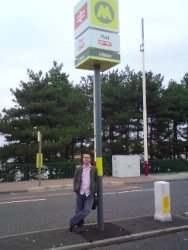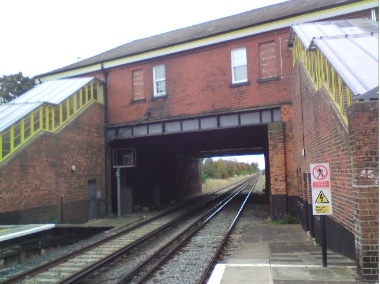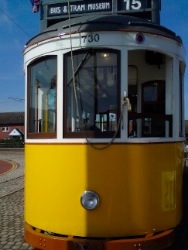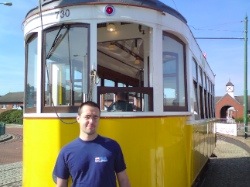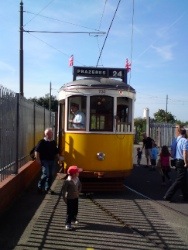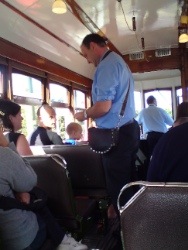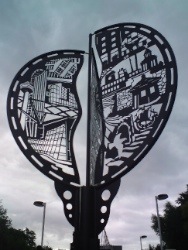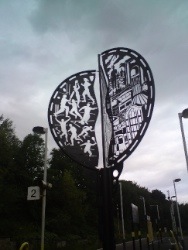Well, if you've been paying attention over the last few months, you'll know that I'm a sick, sick man. I've been off work via a number of doctor's notes since May, due to a complex series of illnesses which basically add up to me being depressed and/or a miserable sod. It's actually not as interesting as it sounds. Basically you just could not give a fuck about anything, ever, anytime, and then you take a whole lot of pills and fall asleep halfway through repeats of Frasier on Comedy Central.
Apathy is really underrated as a depression factor. Not giving a toss about the world means that you can get really excited about something - like, say capturing a couple of railway stations. You really want to do it, and then when it comes down to it you just think, "but if I leave the house I'll miss King of the Hill on FX" and you crawl into bed and fall asleep with your laptop on your knees and half a Mr Kipling Lemon Slice dangling out of the corner of your mouth. This is all theoretical and I promise is not how I spend my days.
 Lying in bed all day sounds great, but trust me the novelty wears off really fast. I find my mind wandering, and very often it goes wandering places I'm not comfortable with. I needed a distraction. The Bf was driving into town, so I got him to drop me at Hamilton Square. I got an All Areas Saveaway and jumped onto a Wirral Line train.
Lying in bed all day sounds great, but trust me the novelty wears off really fast. I find my mind wandering, and very often it goes wandering places I'm not comfortable with. I needed a distraction. The Bf was driving into town, so I got him to drop me at Hamilton Square. I got an All Areas Saveaway and jumped onto a Wirral Line train.
I didn't have a plan in mind. I didn't want to go anywhere in particular. I just wanted to enjoy the ride. I used to do it a lot when I lived in Luton; I'd get a One Day Travelcard and skip from station to station on the Underground, just enjoying the sway of the train and the movement of the commuters. Of course, in London half the journey is just changing from line to line; you need to pack a Sherpa and a bar of Kendal Mint Cake before you attempt to transfer between the Victoria and Circle lines at King's Cross St Pancras. Liverpool's a lot more manageable, but the walk from the Wirral to the Northern lines at Moorfields is still a fair way. I decided to board whatever was the next train into the station, and hovered on the landing between the two platforms in anticipation. A southbound train won the battle, and soon I was headed for Hunts Cross.
I did this section of line in a couple of bursts two years ago, so this wasn't about the stations. This time I was here for the journey itself. The train was crammed with pensioners, and I realised that this was probably the first train out of Southport after 9 am; these grey haired commuters weren't headed for work, but instead for shopping and a day out in town. The only people on the train without a walking stick and a pacamac were me and two skinheads. They were only around nineteen, but they simmered with a resentment and flinty anger which aged them. They pushed ahead of the elderly passengers and leapt from the train at Central, laughing and turning the air as blue as the women's rinses.
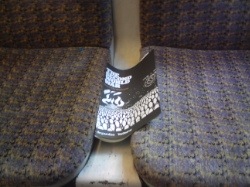 That left only about half a dozen people in our carriage for the trip further south, and we were surrounded by paper detritus - supplements, pull out sections, and the omnipresent Metro. The guard worked his way down the carriage, picking up all the papers on his way. I thought he was going to bin them, but instead he just shoved them on the luggage rack at the end of the carriage - out of sight, out of mind. It meant I never got to read The Guardian's collectible supplement on the Holocaust, to my eternal regret.
That left only about half a dozen people in our carriage for the trip further south, and we were surrounded by paper detritus - supplements, pull out sections, and the omnipresent Metro. The guard worked his way down the carriage, picking up all the papers on his way. I thought he was going to bin them, but instead he just shoved them on the luggage rack at the end of the carriage - out of sight, out of mind. It meant I never got to read The Guardian's collectible supplement on the Holocaust, to my eternal regret.
I peered out the window, looking to see if anything was different in the stations as we went past, and looking for the "ghost" stations on the line. I definitely saw the platforms in the cutting at St James, and I think I saw the overgrown remains of Otterspool too. Cressington looked like it had had a repaint, while the ghosts of Garston were still visible: a patch of empty ground and a road with gates at both ends.
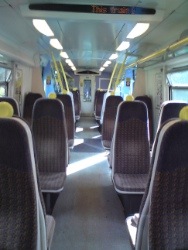 My fellow passengers all got off at Liverpool South Parkway, and I was left alone in the carriage. I stood in the aisle and took a photo to commemorate this rare treat, just as the guard appeared behind me, which was embarrassing.
My fellow passengers all got off at Liverpool South Parkway, and I was left alone in the carriage. I stood in the aisle and took a photo to commemorate this rare treat, just as the guard appeared behind me, which was embarrassing.
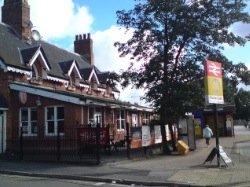 I've always felt a bit sorry for Hunts Cross. It should be important, as the terminus of the Northern Line, but it was always intended as a temporary end, until electrification was continued beyond this point. That never happened. Instead, for a while in the 1980s, passengers from Manchester were forced to get off their train and get on board a Merseyrail one to take them into the city. You can imagine how popular that was, and it was discontinued in 1989. Since then, it's sort of flapped around at the end of the line, and had its thunder as an interchange station (and the interchange circles on the map) stolen by Liverpool South Parkway. It hasn't even got much of a presence on the street, the original Cheshire Lines building having been turned into a pub. The 1980s British Rail "will this do?" replacement is basically somewhere to keep the rain off the ticket seller, nothing more.
I've always felt a bit sorry for Hunts Cross. It should be important, as the terminus of the Northern Line, but it was always intended as a temporary end, until electrification was continued beyond this point. That never happened. Instead, for a while in the 1980s, passengers from Manchester were forced to get off their train and get on board a Merseyrail one to take them into the city. You can imagine how popular that was, and it was discontinued in 1989. Since then, it's sort of flapped around at the end of the line, and had its thunder as an interchange station (and the interchange circles on the map) stolen by Liverpool South Parkway. It hasn't even got much of a presence on the street, the original Cheshire Lines building having been turned into a pub. The 1980s British Rail "will this do?" replacement is basically somewhere to keep the rain off the ticket seller, nothing more.
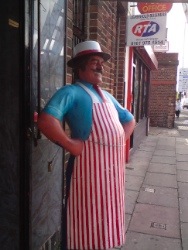 I killed time by wandering around the little arcade next to the station, the usual mix of post office, banks, newsagents and hairdressers you'll get in any local shopping centre. A terrifying statue stood outside the butchers and scared a little girl into her mum's skirts as they walked past. I don't blame her. I mean, look at him. He looks like that weird uncle who used to pick you up from school with his hands in his pockets.
I killed time by wandering around the little arcade next to the station, the usual mix of post office, banks, newsagents and hairdressers you'll get in any local shopping centre. A terrifying statue stood outside the butchers and scared a little girl into her mum's skirts as they walked past. I don't blame her. I mean, look at him. He looks like that weird uncle who used to pick you up from school with his hands in his pockets.
 Once I'd read the local graffiti (the pleasingly nihilistic "Adults By Accident") and done the tour of the Cross I'd exhausted all the area's sights, so I headed back down to the platform. I'd not noticed before that there was a shop in the waiting room, so I bought a Coke and had a sit down and listened to the conversation of the two women across the way. I do love a good eavesdrop, and this one was a Victoria Wood sketch in the making - "I was there talking to me Dad and I fell asleep. Right there in the graveyard. Right there on the grave. Woke up an hour later in the middle of the cemetery."
Once I'd read the local graffiti (the pleasingly nihilistic "Adults By Accident") and done the tour of the Cross I'd exhausted all the area's sights, so I headed back down to the platform. I'd not noticed before that there was a shop in the waiting room, so I bought a Coke and had a sit down and listened to the conversation of the two women across the way. I do love a good eavesdrop, and this one was a Victoria Wood sketch in the making - "I was there talking to me Dad and I fell asleep. Right there in the graveyard. Right there on the grave. Woke up an hour later in the middle of the cemetery."
The train came in, and soon filled with new passengers. There was something different about them though, a different mood, and I worked it out somewhere around Aigburth. They were day-trippers, optimistic folks who'd woken up to the blue skies and decided to treat themselves with a run out to Southport or Formby or Ainsdale.
Their mood was in contrast to mine. I'd slipped into a low, a trough of despair, and I sat on the train thinking dark thoughts, letting myself get drawn into the steady beat of the wheels on the tracks. The 1-2-3-4 noise that repeats and repeats. I pulled out my journal and scribbled in it, my writing scrawled over the page as the movement of the train shook me. I can see why John Betjeman was such a fan of the railways; he must have drawn inspiration from the steady metre beneath his feet.
We went into the tunnel after Brunswick station, and the heavy undernote became a whine, an electric scream which still thrills me. To quote the legends that are Girls Aloud, it's the Sound of the Underground, it's the noise of family day trips to the capital and happy wanderings with friends and the whole world of the Tube. Then the tunnel opened up into the murky yellow light of Liverpool Central. Does no-one at Merseyrail own a 100 watt bulb? The contrast is even more stark when you get to Moorfields, where the white tunnel reflects the light back and makes it bright and airy.
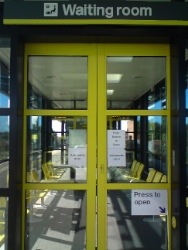 I didn't want to go all the way to Southport, as I'm going to Birkdale in a couple of weeks time anyway, so I decided to use my time productively and explore the new, gleaming Sandhills station. The last time I came here was in the old station's final days, and I wanted to see what had happened to it since. It's been very nicely done by Merseytravel, Network Rail and the DfT. Speaking as someone who occasionally froze my knackers off waiting for a train at the old Sandhills I was pleased to see not one but two waiting rooms, plus a third waiting area by the ticket office. The ticket office, incidentally, has been moved from down on the ground to platform level.
I didn't want to go all the way to Southport, as I'm going to Birkdale in a couple of weeks time anyway, so I decided to use my time productively and explore the new, gleaming Sandhills station. The last time I came here was in the old station's final days, and I wanted to see what had happened to it since. It's been very nicely done by Merseytravel, Network Rail and the DfT. Speaking as someone who occasionally froze my knackers off waiting for a train at the old Sandhills I was pleased to see not one but two waiting rooms, plus a third waiting area by the ticket office. The ticket office, incidentally, has been moved from down on the ground to platform level.
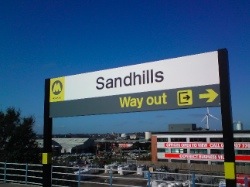 The station is fully DDA compliant, with ramps from the street and a lift to the platform; a canopy covers almost the whole station, so you're shielded from the worst of the elements; and it all looks very shiny and pretty. In fact, there was a man cleaning the windows on the waiting rooms while I was there. It's even got a big swoopy fin roof thing over the stairs. In short, it's got everything you could want from a station... except they've taken away the ALF! There used to be an Attractive Local Feature board here, advising football fans to alight for the Soccerbus to Goodison and Anfield. They've taken it away, but haven't replaced it. I'm disgusted and outraged. I suspect I will be writing a strongly worded e-mail once I've finished blogging.
The station is fully DDA compliant, with ramps from the street and a lift to the platform; a canopy covers almost the whole station, so you're shielded from the worst of the elements; and it all looks very shiny and pretty. In fact, there was a man cleaning the windows on the waiting rooms while I was there. It's even got a big swoopy fin roof thing over the stairs. In short, it's got everything you could want from a station... except they've taken away the ALF! There used to be an Attractive Local Feature board here, advising football fans to alight for the Soccerbus to Goodison and Anfield. They've taken it away, but haven't replaced it. I'm disgusted and outraged. I suspect I will be writing a strongly worded e-mail once I've finished blogging.
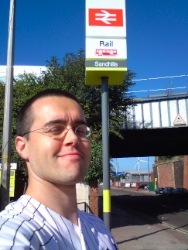 Down on the street level, there's a big patch of bare ground that will one day be a bus exchange, though there was no work going on when I visited. I think it may have been credit crunched. I decided that as this was an all-new, glamorous Sandhills, I'd best tart it again. Besides, it had one of the new box sign boards, rather than the old flat ones.
Down on the street level, there's a big patch of bare ground that will one day be a bus exchange, though there was no work going on when I visited. I think it may have been credit crunched. I decided that as this was an all-new, glamorous Sandhills, I'd best tart it again. Besides, it had one of the new box sign boards, rather than the old flat ones.
I wondered what they did with the old station signs. Here's the answer; they dump them behind a portakabin and leave them to rust. I spotted the discarded sign, and immediately knew I wanted it. I'm sure I could find somewhere to put it in my flat. Perhaps my "strongly worded" e-mail to Merseytravel will be turned into a "pretty please" e-mail.
 So now here I was, in the heart of Liverpool's beautiful* docklands (*actual beauty not guaranteed), with time to kill. I thought I'd go and take a look at a building which had always fascinated me, and which was close by. The Tate & Lyle sugar silo was built in the 1950s, and is a huge arc of concrete on the Dock Road. It's got a brutal charm to it, and its sheer bulk is astonishing.
So now here I was, in the heart of Liverpool's beautiful* docklands (*actual beauty not guaranteed), with time to kill. I thought I'd go and take a look at a building which had always fascinated me, and which was close by. The Tate & Lyle sugar silo was built in the 1950s, and is a huge arc of concrete on the Dock Road. It's got a brutal charm to it, and its sheer bulk is astonishing.
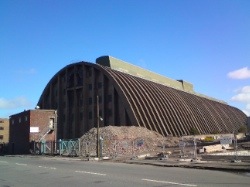 It's a ridiculous building, and I mean that in the very best way. It should be for building Apollo rockets or housing settlers on the moon instead of sugar. If, indeed it still does; the building is Grade II listed, but is on English Heritage's "at risk" register due to being underused. It's a shame if it is no longer in use, and even worse if it were allowed to crumble and die. Like the nearby Stanley Dock warehouse, it's a colossal piece of industrial heritage, and it should be preserved.
It's a ridiculous building, and I mean that in the very best way. It should be for building Apollo rockets or housing settlers on the moon instead of sugar. If, indeed it still does; the building is Grade II listed, but is on English Heritage's "at risk" register due to being underused. It's a shame if it is no longer in use, and even worse if it were allowed to crumble and die. Like the nearby Stanley Dock warehouse, it's a colossal piece of industrial heritage, and it should be preserved.
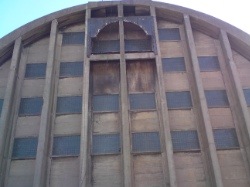 No doubt it was purely suggestion, but I was sure I could taste sweet, sticky toffee on my lips as I took the photographs. Perhaps the air around the warehouse has become thickened with the sugar over the decades.
No doubt it was purely suggestion, but I was sure I could taste sweet, sticky toffee on my lips as I took the photographs. Perhaps the air around the warehouse has become thickened with the sugar over the decades.
But that wasn't the sweetest part of my visit. What does that sign say?
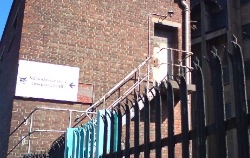 Huskisson! Huskisson Dock Number 3! I was indescribably pleased to see old Willy immortalised again. Also, I just like saying Huskisson! It's actually more fun if you sing it to the "Scorpio!" theme from the Simpsons. Huskisson! (You'll have that in your head for the rest of the day. Trust me.)
Huskisson! Huskisson Dock Number 3! I was indescribably pleased to see old Willy immortalised again. Also, I just like saying Huskisson! It's actually more fun if you sing it to the "Scorpio!" theme from the Simpsons. Huskisson! (You'll have that in your head for the rest of the day. Trust me.)
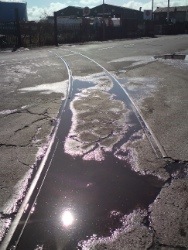 With Huskisson! captured, I figured I should probably get back to the station. It was the middle of the day, but the docks still had a vaguely threatening air to them, as though I could press-ganged at any moment. The rough road surface and cracked pavements didn't exactly instil much confidence either. There were railway tracks all over the place, a reminder that this whole area was once criss-crossed with freight lines, with the Overhead Railway above them. All gone now.
With Huskisson! captured, I figured I should probably get back to the station. It was the middle of the day, but the docks still had a vaguely threatening air to them, as though I could press-ganged at any moment. The rough road surface and cracked pavements didn't exactly instil much confidence either. There were railway tracks all over the place, a reminder that this whole area was once criss-crossed with freight lines, with the Overhead Railway above them. All gone now.
 I'd say my main complaint about the all new Sandhills is that the lift tower is crying out for a big yellow box on top, like the light box on top of the tower at Tate Modern, with the Merseytravel "M" proudly emblazoned on it and visible for miles around. I hope they do get round to building the bus area, and a car park too, because it could be quite a handy park and ride facility. You come within a mile of the city centre but stop before you actually hit the snarled up streets, and then clean efficient underground trains whisk you to the shops. Lovely.
I'd say my main complaint about the all new Sandhills is that the lift tower is crying out for a big yellow box on top, like the light box on top of the tower at Tate Modern, with the Merseytravel "M" proudly emblazoned on it and visible for miles around. I hope they do get round to building the bus area, and a car park too, because it could be quite a handy park and ride facility. You come within a mile of the city centre but stop before you actually hit the snarled up streets, and then clean efficient underground trains whisk you to the shops. Lovely.
The walk back to the station had tired me out completely. Since I started taking anti-depressants I've become weak as a kitten, and the slightest bit of exercise leaves me exhausted. I collapsed onto a chair on the platform, and made some notes in my journal. I realised that I didn't quite look like the cool intellectual writer when I was making notes on a station platform; I looked like a trainspotter. I was too hot and sweaty to care by that point though. I needed sanctuary and rest, somewhere I could go and recharge my body, mind and spirit. Where could I go?
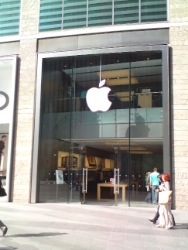 I'm currently coveting a new laptop, so I went in and stroked the MacBooks until a security man asked me to leave. I sat in the gardens of the Bluecoat, one of those gorgeous city spaces you wish no-one else knew about, and caught some sun until one o'clock, when I went off to meet Robert for a pint in his lunch hour. Even though I complained right at the start about having to sit around the house doing nothing, I have to admit a certain amount of schadenfreude when he turned up, roasting hot in a collar and tie.
I'm currently coveting a new laptop, so I went in and stroked the MacBooks until a security man asked me to leave. I sat in the gardens of the Bluecoat, one of those gorgeous city spaces you wish no-one else knew about, and caught some sun until one o'clock, when I went off to meet Robert for a pint in his lunch hour. Even though I complained right at the start about having to sit around the house doing nothing, I have to admit a certain amount of schadenfreude when he turned up, roasting hot in a collar and tie.
The day out worked. I'm not sure if it was the sunny weather, the bright shiny stations, the Huskisson! moment (admit it, you can't stop hearing that tune now, can you?) but I went home feeling a lot jollier than I'd left it. Actually, maybe it was the beer. Yup. It was probably the beer.
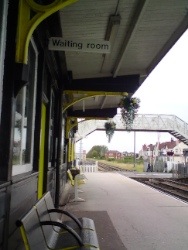 I'm in the middle of a drug shift. The 400,000 pills I used to take are being rationalised and cut down to a more manageable quantity, and as a result I've spent much of the past week in a sort of vague haze. My drug cocktail will hopefully be concentrated down to a drug single malt within a few weeks.
I'm in the middle of a drug shift. The 400,000 pills I used to take are being rationalised and cut down to a more manageable quantity, and as a result I've spent much of the past week in a sort of vague haze. My drug cocktail will hopefully be concentrated down to a drug single malt within a few weeks.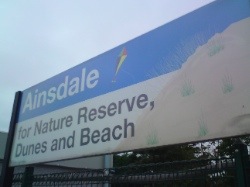 It means that this week's tart is a bit... vague. The first half, anyway. I was in what is known to mental health experts as a "flooby" mood, and so I turned up at Ainsdale with only half of my brain active. This was really not giving Ainsdale its due: it had an ALF, for the first time in simply yonks, and it seemed like a nice enough station.
It means that this week's tart is a bit... vague. The first half, anyway. I was in what is known to mental health experts as a "flooby" mood, and so I turned up at Ainsdale with only half of my brain active. This was really not giving Ainsdale its due: it had an ALF, for the first time in simply yonks, and it seemed like a nice enough station.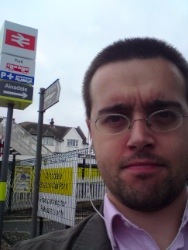 I apologise for the facial hair.
I apologise for the facial hair. I paid my entrance fee (sadly, 502 membership didn't grant free entry, like a Blue Peter badge) and wandered into the exhibition. What is it with men and trains? I found myself wondering this over and over as I wandered around. The age range went from barely out of nappies to just into adult nappies, and all of them were rapt with pleasure at the various different layouts on display. I admit, some of them were beautiful; one of a London Underground station particularly fascinated me. The smell was the musky scent of hobbyists; of men who spent a lot of time in the shed or the attic. Any women present were either sexless converts to the cause or assuming that slightly wide-eyed look of faked interest as little Raymond pointed out another model traction engine.
I paid my entrance fee (sadly, 502 membership didn't grant free entry, like a Blue Peter badge) and wandered into the exhibition. What is it with men and trains? I found myself wondering this over and over as I wandered around. The age range went from barely out of nappies to just into adult nappies, and all of them were rapt with pleasure at the various different layouts on display. I admit, some of them were beautiful; one of a London Underground station particularly fascinated me. The smell was the musky scent of hobbyists; of men who spent a lot of time in the shed or the attic. Any women present were either sexless converts to the cause or assuming that slightly wide-eyed look of faked interest as little Raymond pointed out another model traction engine. 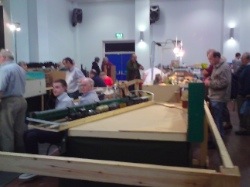 At 2, a dozen members of the 502 group (including friend of the Merseytart and group treasurer Robert) congregated in the dining hall of the school for the AGM. The smell of dining halls is exactly the same as when I was a boy, incidentally; minced beef and fat. So much for Jamie Oliver cleaning them all up. I couldn't contribute very much to the meeting, partly through shyness, partly through ignorance, partly through not being able to hear half the speakers above the general hubbub of the hall, but it was nice to meet people and it felt positive to be there and support the cause. It would be a terrible shame if the train was allowed to dissolve into iron filings. (Donations gratefully received).
At 2, a dozen members of the 502 group (including friend of the Merseytart and group treasurer Robert) congregated in the dining hall of the school for the AGM. The smell of dining halls is exactly the same as when I was a boy, incidentally; minced beef and fat. So much for Jamie Oliver cleaning them all up. I couldn't contribute very much to the meeting, partly through shyness, partly through ignorance, partly through not being able to hear half the speakers above the general hubbub of the hall, but it was nice to meet people and it felt positive to be there and support the cause. It would be a terrible shame if the train was allowed to dissolve into iron filings. (Donations gratefully received).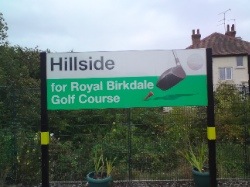 As the ALF says, this is the closest station to Royal Birkdale. Perversely, there's a Birkdale station as well, which I think was probably just named to confuse the Americans. It had received more attention than other stations to make it gleam in time for the Open last year. This was especially pleasing as the station was one of those 1930s gems, and it had been lovingly restored. I cooed with delight at the enormous stone name plates outside:
As the ALF says, this is the closest station to Royal Birkdale. Perversely, there's a Birkdale station as well, which I think was probably just named to confuse the Americans. It had received more attention than other stations to make it gleam in time for the Open last year. This was especially pleasing as the station was one of those 1930s gems, and it had been lovingly restored. I cooed with delight at the enormous stone name plates outside: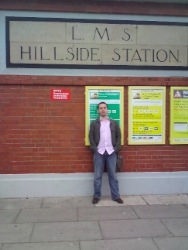 I considered that the Tart, but Robert, stickler for tradition that he is, insisted that I should also be photographed under the Box M sign as well:
I considered that the Tart, but Robert, stickler for tradition that he is, insisted that I should also be photographed under the Box M sign as well: Inside, the Colour Tsars had been at work, of course, but with pleasing results, and the woodwork was sensitively restored. I especially liked the clear plastic roofing over the top of the steps, and the signs have been given the new corporate livery as well. In fact, I cooed over it so much, I began to feel a little bit guilty for paying so little attention to Ainsdale. I think I might have to make a return visit. Guilt is a terrible thing.
Inside, the Colour Tsars had been at work, of course, but with pleasing results, and the woodwork was sensitively restored. I especially liked the clear plastic roofing over the top of the steps, and the signs have been given the new corporate livery as well. In fact, I cooed over it so much, I began to feel a little bit guilty for paying so little attention to Ainsdale. I think I might have to make a return visit. Guilt is a terrible thing.
